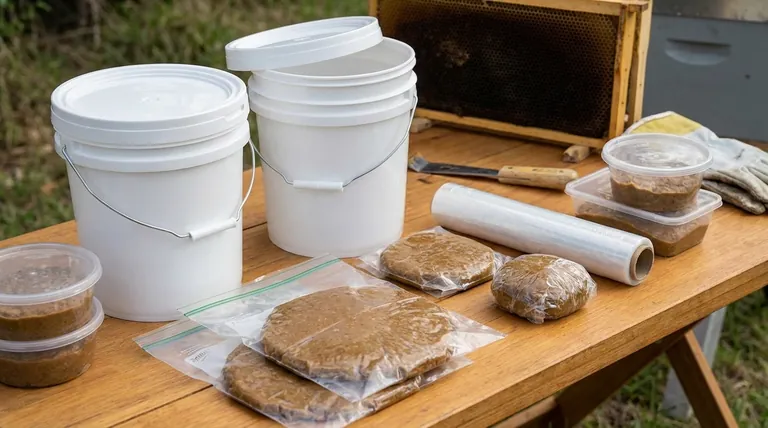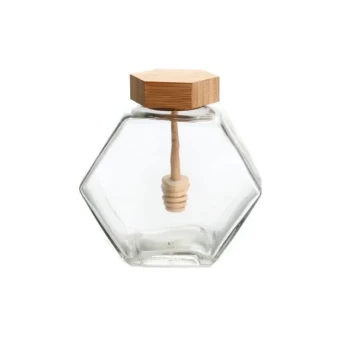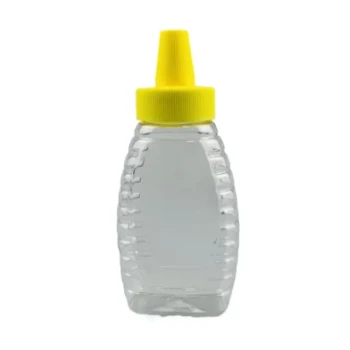The best containers for pollen substitute are common, airtight household items like self-seal food bags, cling wrap, and plastic takeaway containers with lids. The primary goal of any container is to keep air out, which prevents the dough-like mixture from drying and hardening. This ensures it remains soft and palatable long enough for the bees to consume it.
The choice of container is less about long-term storage and more about preparing the substitute for effective feeding. Flexible options like bags or cling wrap are superior because they naturally form the mixture into thin, flat patties, which is the ideal shape for placement inside the hive.

Why Container Choice Matters for Feeding
The container you choose directly impacts how easily you can feed the substitute to your colony and how accessible it is for the bees.
Preventing Dehydration
Airtight storage is non-negotiable. If the pollen substitute mixture is exposed to air, it will quickly dry out and become a hard, unusable block that the bees cannot eat.
All recommended containers—bags, cling wrap, and tubs—achieve this primary goal of keeping the mixture soft and ready for consumption.
Facilitating Easy Placement
The most significant advantage of using bags or cling wrap comes during the feeding process itself. The weight of the pollen substitute naturally flattens the mixture inside a bag into a thin slab.
This thin patty is the perfect shape to be placed directly on top of the brood frames, right under the crownboard or inner cover.
Improving Bee Access
Placing a thin patty of pollen substitute directly above the brood cluster gives the bees maximum access to the food source. They can easily move onto the patty to consume it without having to travel far from the brood they are tending. Rigid containers do not offer this advantage.
Understanding the Trade-offs: Bags vs. Rigid Containers
While several options work for storage, they are not equally effective when it comes to the practical task of feeding your bees.
The Advantage of Flexible Storage (Bags & Cling Wrap)
Using self-seal bags or cling wrap combines storage and preparation into a single, efficient step. You place a portion of the mixture into the bag, seal it, and it's immediately formed into a feed-ready patty.
This method is clean, requires no extra tools, and creates the ideal shape for in-hive placement.
The Limitation of Rigid Containers (Takeaway Tubs)
Plastic takeaway containers are excellent for storing a large batch of pollen substitute. However, they are only a storage solution, not a feeding one.
To feed the bees, you will have to scoop the mixture out of the tub and manually form it into a patty. This creates an extra, often messy, step in the process.
A Critical Note: When to Feed
Before preparing any substitute, it is essential to determine if your bees actually need it. The most effective strategy is often to feed nothing at all.
Avoid Unnecessary Feeding
There is no benefit to feeding pollen substitute when your bees have access to adequate natural pollen of high nutritional value. Colonies will always prefer and do better on natural forage.
Conserve Your Resources
Supplemental feeding should only be done when there is a genuine lack of natural pollen. Feeding when it is not needed is a waste of your money, time, and resources.
Making the Right Choice for Your Goal
Your choice of container should align directly with your feeding strategy and timing.
- If your primary focus is immediate feeding and optimal placement: Use self-seal food bags or cling wrap to form thin, flat patties that are ready for direct placement on the brood frames.
- If your primary focus is bulk storage of a large batch: Use airtight plastic takeaway containers for initial storage, but plan to form the substitute into patties before taking it to the apiary.
Ultimately, choosing the right storage method simplifies the feeding process and ensures your colony gets the full benefit of the supplemental nutrition when they truly need it.
Summary Table:
| Container Type | Primary Use | Key Advantage | Ideal For |
|---|---|---|---|
| Self-seal Bags / Cling Wrap | Feeding Preparation | Forms ready-to-use patties | Immediate, optimal hive placement |
| Plastic Takeaway Tubs | Bulk Storage | Airtight for large batches | Storing a large mix for later use |
Simplify your beekeeping operations with HONESTBEE.
As a trusted supplier for commercial apiaries and beekeeping equipment distributors, we provide the high-quality, wholesale supplies you need for efficient and effective colony management—from feeding essentials to full-scale equipment.
Ready to streamline your process? Contact our team today to discuss your needs and discover how our products support your success.
Visual Guide

Related Products
- Food Grade Plastic Honey Bucket Pail for Beekeeping
- Professional Plastic Queen Excluder for Modern Beekeeping
- Professional Galvanized Hive Strap with Secure Locking Buckle for Beekeeping
- Wooden Queen Bee Excluder for Beekeeping
- Hexagonal Glass Honey Jar with Wooden Lid Integrated Dipper Elegant Functional Storage
People Also Ask
- Can you store honey in a plastic bucket? Yes, with the right food-grade HDPE.
- What types of containers are ideal for storing liquid honey? Preserve Quality with Glass or Plastic
- What are plastic buckets called? The Essential Guide to Plastic Pails
- Can we store honey in stainless steel container? A Guide to Safe, Bulk Honey Storage
- How long can you store honey in a 5 gallon bucket? Preserve Quality & Safety for Decades



















